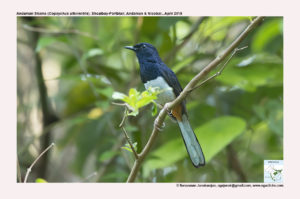Andaman Shama

Andaman Shama Copsychus malabaricus albiventris
Etymology :
- Copsychus : Greek word for Blackbird
- Malabaricus : From Malabar region in Kerala, India
- Albiventris: Latin wordalbus –white; ventris-belly
Distribution in India: Resident of Andaman & Nicobar Island.
Description: Size of 25 cm including tail of 12 cm. The adult has white underparts with rear flanks tinged rufous, pale orange or warm brown, becoming more solidly rufous on undertail-coverts. It has a shorter tail with black central feathers projecting only slightly beyond white outer tail-feathers, colder-glossed upperparts with a scalier appearance, but wing fringes generally darker. Both the sexes are very similar, but female is very marginally duller on chin and throat, and shorter-tailed (98–106 mm vs. 117–122 mm of male), but is glossed bluer above. The juvenile is very dark, with faintly buff-streaked blackish upperparts, blackish throat and breast is heavily spotted rufous, and rest of underparts as adult.
Habitat: It is found in dense forest, scrub and gardens and densely vegetated ravines near water. It keeps low above ground or is terrestrial.
Food habits: It eats ants, caterpillars, moths, beetles, flies, grasshoppers, centipedes, spiders, also worms and berries.
Breeding habits: They breed in May–Jun. The nest is made up of grasses and dry bamboo leaves, lined with fine roots, twigs and rhizomorphs, sited in a broken stump or crevice above ground, usually within dense vegetation. They lay a clutch of 2–3 eggs.